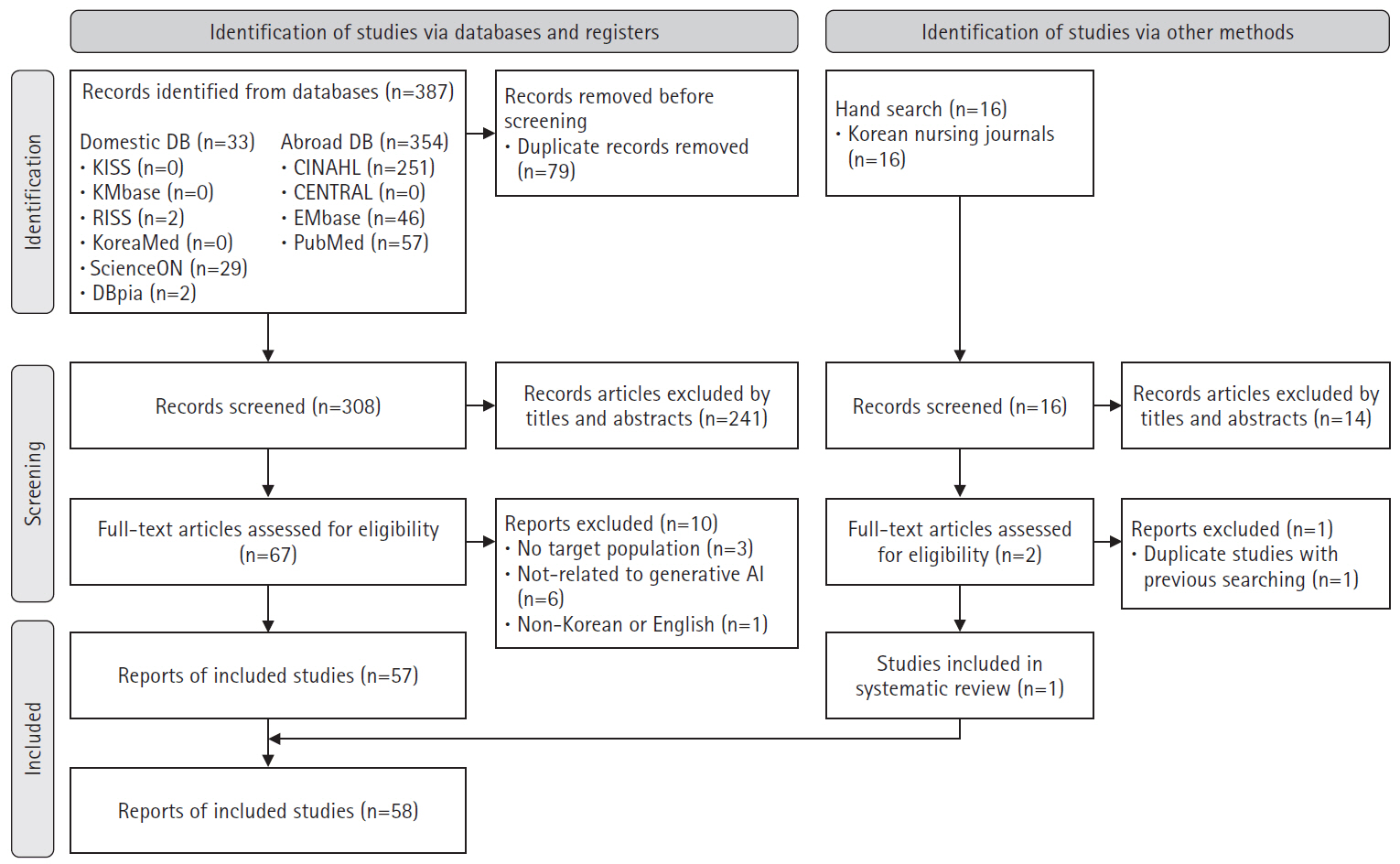-
Research trends in generative artificial intelligence in nursing: a scoping review
-
Myung Jin Choi, Myoung Hee Seo, Jihun Kim, Sunmi Kim, Seok Hee Jeong
-
J Korean Acad Nurs 2025;55(3):468-487. Published online August 5, 2025
-
DOI: https://doi.org/10.4040/jkan.25006
-
-
 Abstract Abstract
 PDF PDF ePub ePub
- Purpose
Generative artificial intelligence (AI) has yet to be comprehensively analyzed in the nursing literature. This study aimed to identify research trends in generative AI within the nursing field through a scoping review and propose strategies for its effective utilization in nursing.
Methods
A scoping review was conducted following Arksey and O’Malley’s six-stage framework. The inclusion criteria included: (1) studies conducted in nursing; (2) research related to generative AI; and (3) original research articles, theses, communications, editorials, letters, or commentaries published in academic journals. Database used PubMed, Embase, CENTRAL, CINAHL, KMbase, KoreaMed, KISS, ScienceON, RISS, DBpia, and 27 nursing-specific journals.
Results
In total, 403 studies were initially identified, and 58 were included in the final analysis. In the care domain, strengths included rapid information retrieval and improved nurse-patient communication, while limitations included the irreplaceable human element and low reliability. The administration domain had no relevant studies. In the research domain, generative AI exhibited strengths such as enhanced efficiency in the paper writing process and improved dissemination speed, but its weaknesses included lack of ethical and legal accountability and a risk of inaccurate or biased information. In the education domain, generative AI was effective in saving time in educational design and implementation, as well as supporting content creation, but challenges included algorithmic bias and risks of plagiarism.
Conclusion
This study identified potential benefits and limitations of generative AI across nursing domains. For effective application, it is essential to develop comprehensive guidelines and policies, provide user education and support, and create opportunities for nurses, educators, and students to learn about strengths and risks of generative AI.
-
Impact of Anthropometric Indices of Obesity on the Risk of Incident Hypertension in Adults with Prehypertension: A Secondary Analysis of a Cohort Study
-
Se Young Jang, Jihun Kim, Seonhwa Kim, Eun Sun Lee, Eun Jeong Choi
-
J Korean Acad Nurs 2024;54(1):18-31. Published online February 29, 2024
-
DOI: https://doi.org/10.4040/jkan.23067
-
-
 Abstract Abstract
 PDF PDF
- Purpose
This study aimed to investigate the impact of anthropometric indices of obesity (body mass index [BMI], waist circumference, waist hip ratio, and body fat percentage) on the incidence of hypertension in adults with prehypertension.
Methods
A longitudinal study design using secondary data form the Korean Genome and Epidemiology Study was employed. The study included 1,838 adults with prehypertension tracked every two years from 2001 to 2018. Statistical analyses, including frequency assessments, number of cases per 1,000 person-years, log-rank tests, Kaplan-Meier curves, and Cox’s proportional hazards regression, were conducted using SPSS version 25.
Results
Over the observation period (15,783.6 person-years), 1,136 individuals developed hypertension. The incidence of hypertension was significantly higher in the obesity groups defined by BMI (hazard ratio [HR] = 1.33), waist circumference (HR = 1.34), waist hip ratio (HR = 1.29), and body fat percentage (HR = 1.31) compared to the non-obese group. These findings indicate an increased risk of hypertension associated with obesity as measured by these indices.
Conclusion
The study underscores the importance of avoiding obesity to prevent hypertension in individuals with prehypertension. Specifically, BMI, waist circumference, waist hip circumference, and body fat percentage were identified as significant risk factors for hypertension. The results suggest the need for individualized weight control interventions, emphasizing the role of health professionals in addressing the heightened hypertension risk in this population.
-
Citations
Citations to this article as recorded by  - Investigating the Gut Microbiota Profile in Prehypertensive Individuals Exhibiting Phlegm-Dampness Constitution
Ning Yu, Yaotang Yang, Guangyun Wang, Yanhong Wang, Mei Feng, Peilin Yang, Shuang Liu, Rui-rui Wang, Lei Zhang
Frontiers in Cellular and Infection Microbiology.2025;[Epub] CrossRef - Association between body roundness index and psoriasis among US adults: a nationwide population-based study
Genlong Bai, Yuting Peng, Qian Liu, Xinyi Shao, Yuan Zhan, Aijun Chen, Jingbo Zhang
Lipids in Health and Disease.2024;[Epub] CrossRef
-
1,335
View
-
79
Download
-
2
Web of Science
-
2
Crossref
|






